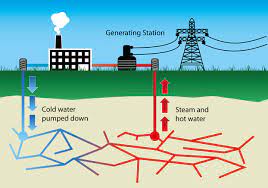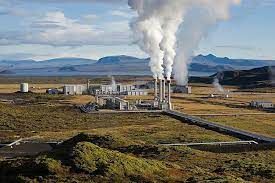Courtesy : indianpowersector.com
Geothermal and wind energy
is used to describe energy sources that are replenished by natural processes on a sufficiently rapid time-scale so that they can be used by humans more or less indefinitely, provided the quantity taken per unit of time is not too great. Renewable energy is derived from natural processes that are replenished constantly. In its various forms, it derives directly from the sun, or from heat generated deep within the earth.
Included in the definition is electricity and heat generated from:
- solar,
- wind,
- ocean,
- hydropower,
- biomass,
- geothermal resources, and
- biofuels and hydrogen derived from renewable resources.
Although biomass is a renewable energy, this should not be mistaken for a clean energy source. Although biomass is significantly cleaner than most fossil fuels such as coal and oil, it still produces sulphur dioxide during electricity production.
Renewable energy replaces conventional fuels in four distinct areas:
- Power Generation,
- Hot Water/ Space Heating,
- Transport Fuels, and
- Rural (off-grid) Energy Services
Current Situation of Renewable Energy
Global Scenario:
- In 2008, about 19% of global final energy consumption came from renewables, with 13% coming from traditional biomass, which is mainly used for heating, and 3.2% from hydroelectricity.
- New renewables (small hydro, modern biomass, wind, solar, geothermal, and biofuels) accounted for another 2.7% and are growing very rapidly.
- The share of renewables in electricity generation is around 18%, with 15% of global electricity coming from hydroelectricity and 3% from new renewables.
- Wind power is growing at the rate of 30% annually, with a worldwide installed capacity of 158 gigawatts (GW) in 2009, and is widely used in Europe,Asia, and the United States.
- At the end of 2009, cumulative global photovoltaic (PV) installations surpassed 21 GW and PV power stations are popular in Germany and Spain.
- Solar thermal power stations operate in the USA and Spain, and the largest of these is the 354 megawatt (MW) SEGS power plant in the Mojave Desert.
- The world’s largest geothermal power installation is The Geysers in California, with a rated capacity of 750 MW.
- Brazil has one of the largest renewable energy programs in the world, involving production of ethanol fuel from sugar cane, and ethanol now provides 18% of the country’s automotive fuel. Ethanol fuel is also widely available in the USA.
- Globally, an estimated 3 million households get power from small solar PV systems.
- More than 30 million rural households get lighting and cooking from biogas made in household-scale digesters.
- Biomass cookstoves are used by 160 million households.
Indian Scenario:
- Current installed base of Renewable Energy Sources(RES) is 18454.52 MW which is10.63% of total installed base with the southern state of Tamil Nadu contributing nearly a third of it (5008.26 MW) largely through wind power (as on 31/03/2011 by CEA)
- R.E.S. INCLUDES :- SHP – 2900 MW , WIND – 12000 MW,B.P. & B.G. –2313.33 MW, U&I & SOLAR – 114.74 MW(SHP – SMALL HYDRO POWER, B.P. – BIOMASS POWER, B.G.- BIOMASS GASIFIER, U&I – URBAN & INDUSTRIAL WASTE)
- India is the 4th largest country with regard to installed power generation capacity in the field of renewable energy source.
- The country has an estimated renewable energy potential of around 85,000 MW from commercially exploitable sources: Wind, 45,000 MW; small hydro, 15,000 MW and biomass/bioenergy, 25,000 MW. In addition, India has the potential to generate 35MW per square km using solar photovoltaic and solar thermal energy.
- In July 2009, India unveiled a $19 billion plan, Jawaharlal Nehru National Solar Mission, to produce 20,000 MW of solar power by 2020
- Tamil Nadu accounts for one third of total RES installed capacity in India followed by Maharashtra, U.P and Andhra Pradesh
- The daily average solar energy incident over India varies from 4 to 7 kWh/m2
- India has the fifth largest installed wind power capacity in the world.
- The availability of biomass in India is estimated at about 540 million tones per year covering residues from agriculture, forestry, and plantations. By using these surplus agriculture residues, more than 16,000 MW of grid quality power can be generated.
- India has reasonably good potential for geothermal; the potential geothermal provinces can produce 10,600 MW of power.
Major Types of Power stations based on Renewable Energy Sources are:
- Solar Energy
- Wind Energy
- Biomass Energy
- Geothermal
- Tidal Energy
Solar Energy
India is both densely populated and has high solar insolation, providing an ideal combination for solar power in India. India is already a leader in wind power generation (Wind power in India) and, Suzlon Energy is one of the India-based pioneering industries in world to generate non-conventional energy. In solar energy sector, some large projects have been proposed, and a 35,000 km² area of the Thar Desert has been set aside for solar power projects, sufficient to generate 700 to 2,100 gigawatts.
In July 2009, India unveiled a $19 billion plan, to produce 20 GW of solar power by 2020.Under the plan,….
Wind Energy
The development of wind power in India began in the 1990s, and has significantly increased in the last few years. Although a relative newcomer to the wind industry compared with Denmark or the US, India has the fifth largest installed wind power capacity in the world.
As of 31 October 2009 the installed capacity of wind power in India was 11806.69 MW, mainly spread across Tamil Nadu (4889.765 MW), Maharashtra (1942.25 MW), Gujarat (1565.61 MW), Karnataka (1340.23 MW), Rajasthan (738.5 MW), Madhya Pradesh (212.8 MW), Andhra Pradesh (122.45 MW), Kerala (26.5 MW), Odisha (2MW), West Bengal (1.1 MW) and other states…
Biomass Energy
Biomass (plant material) is a renewable energy source because the energy it contains comes from the sun. Through the process of photosynthesis, plants capture the sun’s energy. When the plants are burned, they release the sun’s energy they contain. In this way, biomass functions as a sort of natural battery for storing solar energy. As long as biomass is produced sustainably, with only as much used as is grown, the battery will last indefinitely.
In general there are two main approaches to using plants for energy production: growing plants specifically for energy use, and using the residues from plants that are…
Geothermal
The word geothermal comes from the Greek words geo (earth) and therme (heat). So, geothermal energy is heat from within the Earth. We can recover this heat as steam or hot water and use it to heat buildings or generate electricity.It is a natural part of the energy flow within the Earth’s depths. Generally speaking, the further down one drills, the hotter the temperatures. Most of the commercial-grade production geothermal energy is harvested along localized “geothermal systems”, where the heat flow is near enough to the surface that hot water or steam is able to rise either to the surface, or to depths that we can reach by drilling. Many of these regions occur within the “ring of fire“, a ring of geothermal sites…
Tidal Power
Tidal power is the only form of energy which derives directly from the relative motions of the Earth–Moon system, and to a lesser extent from the Earth–Sun system. The tidal forces produced by the Moon and Sun, in combination with Earth’s rotation, are responsible for the generation of the tides. Tidal power is the only form of energy which derives directly from the relative motions of the Earth–Moon system, and to a lesser extent from the Earth–Sun system. The tidal forces produced by the Moon and Sun, in combination with Earth’s rotation, are responsible for the generation of the tides…




